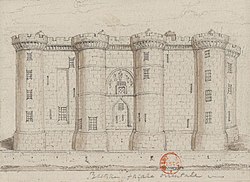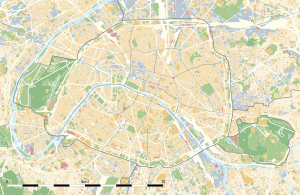| Bastille | |
|---|---|
| Paris, France | |
 East view of the Bastille, drawing c. 1790 | |
| Coordinates | 48°51′12″N 2°22′09″E / 48.85333°N 2.36917°E |
| Type | Medieval fortress, prison |
| Site information | |
| Condition | Destroyed, limited stonework survives |
| Site history | |
| Built | 1370–1380s |
| Built by | Charles V of France |
| Demolished | 1789–1790 |
| Events | Hundred Years' War Wars of Religion Fronde French Revolution |
The Bastille (/bæˈstiːl/, French: [bastij] ) was a fortress in Paris, known as the Bastille Saint-Antoine. It played an important role in the internal conflicts of France and for most of its history was used as a state prison by the kings of France. It was stormed by a crowd on 14 July 1789, in the French Revolution, becoming an important symbol for the French Republican movement. It was later demolished and replaced by the Place de la Bastille.
The castle was built to defend the eastern approach to the city from potential English attacks during the Hundred Years' War. Construction was underway by 1357, but the main construction occurred from 1370 onwards, creating a strong fortress with eight towers that protected the strategic gateway of the Porte Saint-Antoine heading out to the east. The innovative design proved influential in both France and England and was widely copied. The Bastille figured prominently in France's domestic conflicts, including the fighting between the rival factions of the Burgundians and the Armagnacs in the 15th century, and the Wars of Religion in the 16th. The fortress was declared a state prison in 1417; this role was expanded further, first under the English occupiers of the 1420s and 1430s, and then under Louis XI in the 1460s. The defences of the Bastille were fortified in response to the Imperial threat during the 1550s, with a bastion constructed to the east of the fortress. The Bastille played a key role in the rebellion of the Fronde and the Battle of the Faubourg St Antoine, which was fought beneath its walls in 1652.
Louis XIV used the Bastille as a prison for upper-class members of French society who had opposed or angered him including, after the revocation of the Edict of Nantes, French Protestants. From 1659 onwards, the Bastille functioned primarily as a state penitentiary; by 1789, 5,279 prisoners had passed through its gates. Under Louis XV and XVI, the Bastille was used to detain prisoners from more varied backgrounds, and to support the operations of the Parisian police, especially in enforcing government censorship of the printed media. Although inmates were kept in relatively good conditions, criticism of the Bastille grew during the 18th century, fueled by autobiographies written by former prisoners. Reforms were implemented and prisoner numbers were considerably reduced. In 1789, the royal government's financial crisis and the formation of the National Assembly gave rise to a swelling of republican sentiments among city-dwellers. On 14 July, the Bastille was stormed by a revolutionary crowd, primarily residents of the Faubourg Saint-Antoine who sought to commandeer the valuable gunpowder held within the fortress. Seven remaining prisoners were found and released and the Bastille's governor, Bernard-René de Launay, was killed by the crowd. The Bastille was demolished by order of the Committee of the Hôtel de Ville. Souvenirs of the fortress were transported around France and displayed as icons of the overthrow of despotism. Over the next century, the site and historical legacy of the Bastille featured prominently in French revolutions, political protests and popular fiction, and it remained an important symbol for the French Republican movement.
Almost nothing is left of the Bastille, except some remains of its stone foundation that were relocated to the side of Boulevard Henri IV. Historians were critical of the Bastille in the early 19th century, and believe the fortress to have been a relatively well-administered example of French policing and political control during the 18th century.
